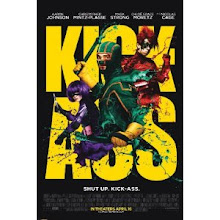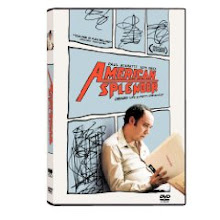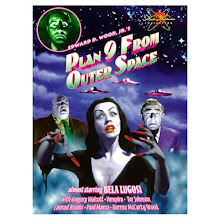Monday, September 28, 2009
The Wrong Stuff
Sunday, September 27, 2009
Some Thoughts on "Mysterious Skin"
by Jason Pyles
Some films simply defy the imposition of a critical voice. I believe “Mysterious Skin” is one such rare film. And yet I brazenly proceed, because it’s my unholy duty (albeit self-appointed, on this site) as a film critic.
Unless one is careful, critiquing a film that tries to communicate such sober themes can trivialize the weighty matters at hand in order to nitpick — or praise — its execution. For example, after being utterly blown away by the emotional power and devastating nature of “Mysterious Skin,” I opted to watch the theatrical trailer on the DVD. (It can also easily be seen at IMDb.com.)
As is common with critically celebrated films, the preview boasted favorable comments from prominent film critics, including this phrase from the New York Times’ A.O. Scott: “...a remarkably poised performance by Joseph Gordon-Leavitt.” I agree with Scott’s description of Gordon-Leavitt’s acting, but the more I thought about it, the more I felt that any cleverly written observation I or any other critic could devise would only make noise where there should be silence. A pensive, reflective silence.
“Mysterious Skin” is so unsettling and upsetting, it almost seems like one should observe some sort of quiet moment of respect for the countless abused victims this film bleeds for, before tearing in to an assessment of it. And now, having taken such precautions, I will proceed:
Though it never explicitly or graphically depicts the actual child abuse scenarios, “Mysterious Skin” is disturbing because it places us on the inside of the crimes, and to some degree, in the mind of the abuser. The film’s concluding revelations — which are primarily verbal descriptions — are nearly unbearable. It’s no wonder some children “go away,” mentally, to escape the experience when such things occur. I felt myself wanting to “escape the film.”
Actually, this sense of spectator resistance reminds me of bell hooks’ concept, “the oppositional gaze.” She wrote an essay called “The Oppositional Gaze: Black Female Spectators.” It focuses on black women’s tendency, generally speaking — according to hooks — to eschew terrible portrayals of black women, or an altogether lack of portrayal of black women, in film. And though I had a film professor once scold me for suggesting that I, a white male, had ever experienced spectator’s resistance or something akin to the oppositional gaze, I still believe that even a white male like me can want to escape unthinkable themes and depictions in movies, even if they don’t coincide with the plight of African-American women in the cinema.
Another unforgettable scene in “Mysterious Skin,” unlike any I’ve ever experienced in the cinema, is a situation where the young Neil preys upon some poor kid on Halloween, sending off fireworks from his face, then proceeds to “appease” him afterward, as a sort of sick consolation. I was utterly horrified and repulsed by this scene, which was no doubt the intention.
Also, it is clear that either Scott Heim, the author of the novel this movie is adapted from, or director Gregg Araki — or both — went to great lengths not to suggest that Neil’s molestation led to his homosexuality. Indeed, before the abuse ever begins, the film lets us know (though it seems unlikely, according to my memory) that Neil has a significant sexual appetite as a biologically young boy. On this point, I think the film was too heavy-handed in establishing Neil’s intense desire for other males.
And finally, many films have addressed prostitution, and many of them have done it irresponsibly. But the responsible portrayals, such as the one in “Mysterious Skin,” reinforce the perils of such a profession. From what I understand (though I admit I have never worked in such a field), films that show brutal encounters when the working gal (or guy) is ravished are conveying an accurate, fairly common occupational hazard. “Monster” is another example, with a twist.
Moral of this story: Stop pedophilia and prostitution. Sure, but I’m afraid it’s much more complicated than that, which is why “Mysterious Skin” aims to stir and afflict its viewers. It succeeds.
Sunday, September 20, 2009
Urban Menace - or how I wasted my Sunday, by Andy
comments by Andy
Sunday, September 13, 2009
"The Stuff" as reviewed by Andy
"The Stuff" is a spoof, as far as I can tell, of the 80's ice cream fad, or should I say ice-scream fad. I feel really stupid for just having written that, but it so typifies the silliness of the movie. I, of course, eat a lot of ice cream because I'm LDS, so I don't remember there being a fad in the 8o's for ice cream and more than today...
The proprietors of "The Stuff" as it's known in the movie, discovered the substance at some sort of industrial mine. It happened to taste good (who tastes glowing white crap eeking out of the ground?), so they shut down the mine and start marketing and selling THE STUFF as a replacement for other deserts. It quickly becomes a nationwide fad, replacing almost all other food in many consumers' diets. The tag line for the marketing is something like "the more you eat, the more you want..." And that's what happens, only the addiction people have to THE STUFF is biological. THE STUFF IS ALIVE!!!!!
I'm not sure what the purpose of THE STUFF was, but it apparently got really pissed when the hero started figuring out what THE STUFF was. He, of course, wasn't investigating for any altruistic reason; he was paid by the dairy conglomerates at some sort of secret corporate espionage yacht-meeting. And hilarity ensues.
Enjoyable, but I'm not sure that the movie shouldn't have been in our section of worst movies. It certainly wasn't as bad as several of the movies on our list, but I would probably put it in the same category as the other cult-classics "Blood Diner," and "Plan 9 from Outer Space." Shockingly deep cast for such a silly pseudo-horror film. Also, I'm not sure why it was rated R (don't remember any bad words, scenes, etc., and the horror was no big deal).
thoughts by Andy
Sunday, September 6, 2009
Mysterious Skin by Andy
So what is the value, then, for me to watch this kind of a movie? Other than my man-crush on J. Gordon-Leavitt? I think the value it held for me was in the true drama of it. Bad things happen to good/innocent people, and sometimes good/innocent people are ruined by traumatic experiences. In our story, Neil and Brian have totally different reactions to the same traumatic sexual abuse.
Neil is noticeably deeply affected by his coach's abuse, so much so that his whole sexual identity is warped and destroyed (by the way, as a side note, I'm not suggesting that abusing kids make them gay or that gay people were abused or that Neil, as a character, chose to be gay: I personally believe homosexuality is not a "choice"). His life spirals down hill at a pretty decent clip until he finally realizes that it was his reaction (re: failure to deal with) the abuse that has lead him to be a male prositute. It doesn't say at the end, but I'm guessing that Araki intended Neil's rape to be his "rock bottom." Hopefully Neil climbs his way out - real life statistics are against him for sure.
Brian is the outwardly opposite situation. He is shy, reserved, and prudish to Neil's extroverted, showy, whorish personality. Brian has struggled through his whole life with acute traumatic amnesia about his event. He blocks it out with only a nosebleed to remember it by. He was the real story, I think. He lived a fairly normal life (albeit completely absent of any kind of romantic experience). I wonder at the end whether Brian's ultimate recollection of the abuse was cathartic or a huge emotional setback. I wonder if blocking bad memories is so bad. His "rock bottom" was in many ways worse than Neil's (even though Neil's life was seemingly so much more destructive) because how far he fell and how fast he did. I wonder how quickly he came to grips with his abuse and how long before his life returned to a sense of normalcy.
Not a fun film for sure, but the acting was excellent and the drama very compelling.
comments by Andy





























































